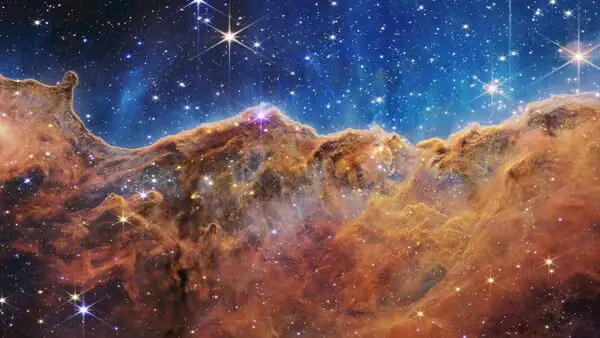NASA Announces the Most Recent James Webb Space Telescope Finding
The waiting is over. The first scientific image from the James Webb Space Telescope has captivated astronomers. The most thorough astronomical representation of the distant Universe was displayed by US President Joe Biden on Monday during a news conference at the White House. On July 12, NAS made further images available.
The initial image, which showed how the James Webb Space telescope may be altered, was carefully guarded before it was made public. It shows thousands of distant galaxies in the constellation Volans that are fainter than any galaxies observed before on a patch of sky that is scarcely larger than that covered by a grain of sand held at arm’s length.
NASA Announces the Most Recent James Webb Space Telescope Finding
The photograph, according to Biden, “shows the earliest documented light in the history of the Universe, from over 13 billion — let me repeat that again — 13 billion years ago.” It’s difficult to even imagine.
Vivian U, an astronomer at the University of California, Irvine, adds, “I’m just amazed.” I’m merely scanning the image to identify the many smudges and determine their causes.
The James Webb Space Telescope, the largest telescope ever sent into orbit, is predicted to revolutionise cosmological research. The first series of images, which includes the deep-field image, covers the early Universe, the evolution of galaxies and stars, and planets outside the Solar System.
NASA: A Revolutionary Telescope: The James Webb Space Telescope
Unlike one of the largest and most well-known space telescopes, the Hubble, the James Webb Space Telescope primarily detects infrared wavelengths. By studying infrared light, which can penetrate the dust clouds that surround nascent stars, it can peer deeper into the cosmos than ever before. According to Zolt Levay, a retired astronomer and image processor who spent decades processing Hubble imagery, Webb “is not Hubble version 2 – it’s a very different instrument.” “What we’re seeing is intangible light.”
Due to the universe’s expansion, which has transferred galaxies’ light from the visible to the infrared portion of the electromagnetic spectrum, due to their distance from Earth, galaxies can only be seen at infrared wavelengths. The first deep-field image taken by the James Webb Space Telescope shows this effect clearly close to the SMACS 0723 galaxy cluster, which is around 4 billion light-years away from Earth. Because the gravitational attraction of the clusters bends and magnifies the light of things behind them, astronomers can view extremely distant objects.
The warped galaxies are what capture Lisa Dang’s attention, an astronomer at McGill University in Montreal, Canada. “They don’t resemble any other galaxies that we are aware of,”
NASA Almost around the moment of the Big Bang that created the universe 13.8 billion years ago, the first image from Webb shows galaxies that may have existed before 13 billion years ago. It makes us think of some well-known deep-field images taken by the Hubble space telescope.
The first of them revealed that a section of the sky that seemed to be empty was really peppered with thousands of previously unidentified galaxies during the course of ten days during the 1995 Christmas vacations. Webb’s first image took just 12.5 hours to create, compared to the weeks it took Hubble to explore other deep fields.
Spectroscopy, or the study of how light interacts with matter at various wavelengths, is a specialty of the James Webb Space Telescope. In contrast to photographs, Webb’s infrared spectra of celestial objects can reveal information about their chemical makeup. That’s where some of the most intriguing science will take place, according to Elizabeth Kessler, a historian at Stanford University in California who has studied the aesthetic impact of Hubble photographs.
An additional $1 billion in funding for the telescope came from NASA’s allies, the Canadian and European space agencies. The James Webb Space Telescope was finally launched in December 2021 after spending six months building its scientific sensors; it will continue to function for at least 20 years.

